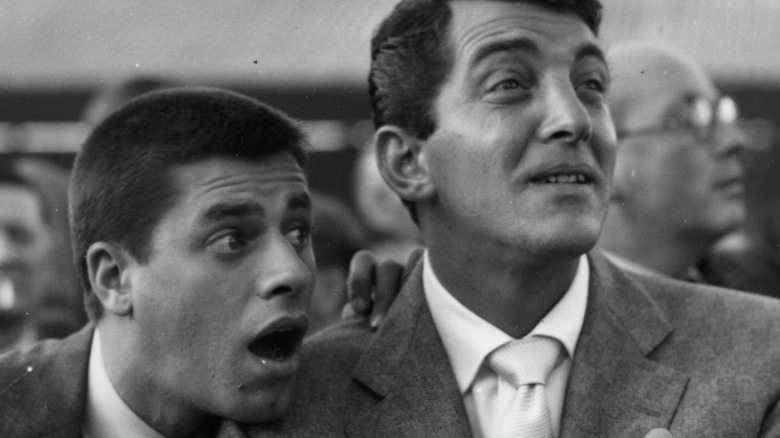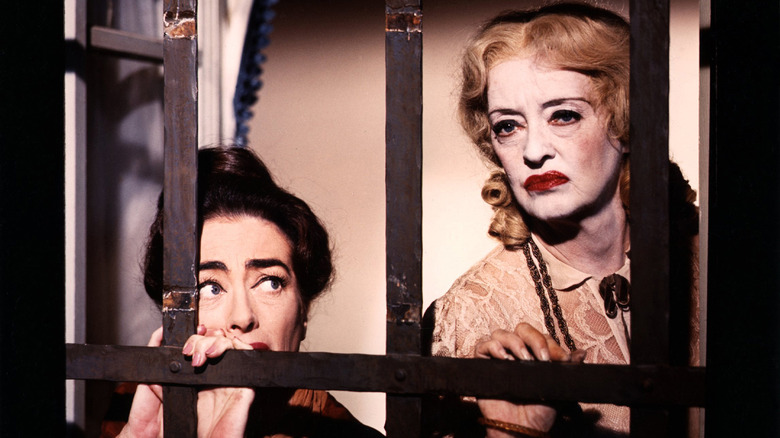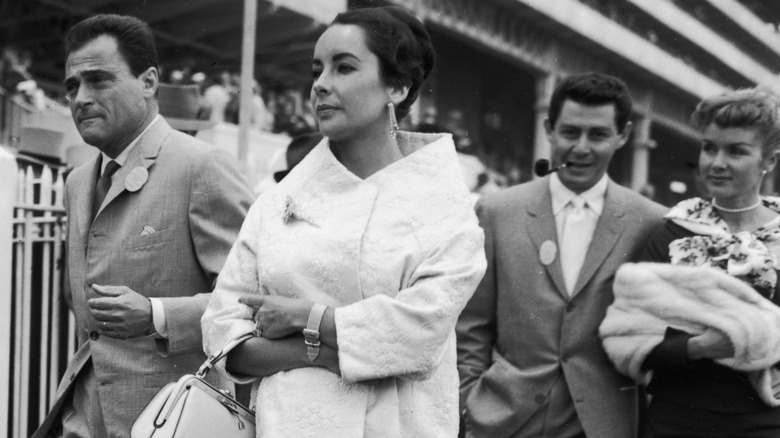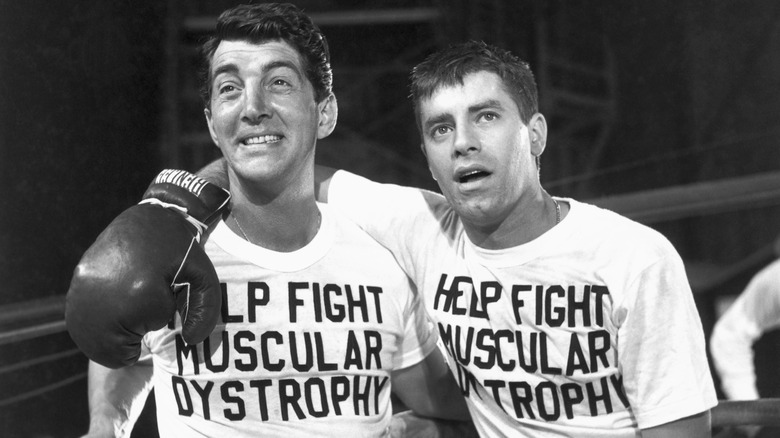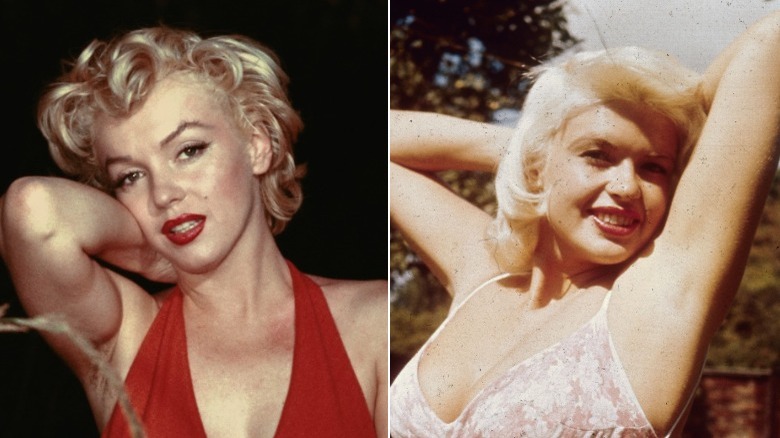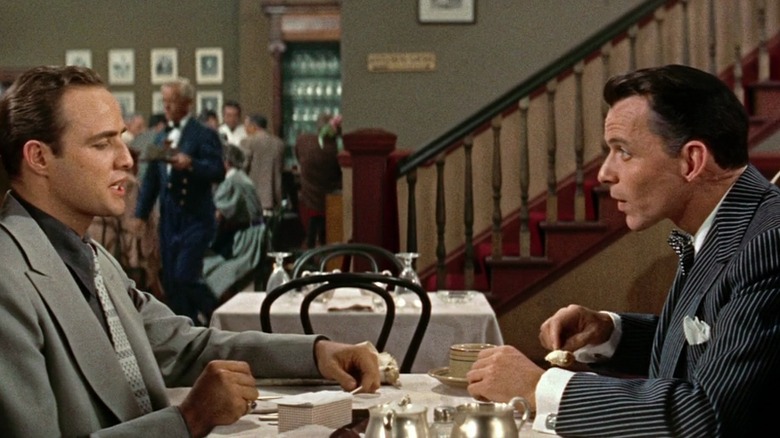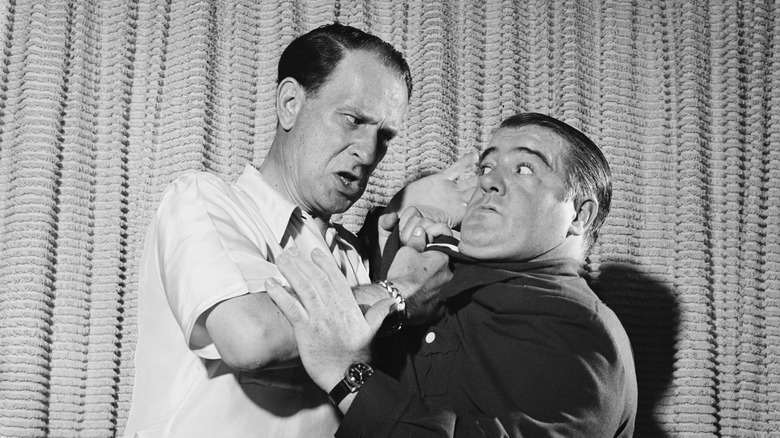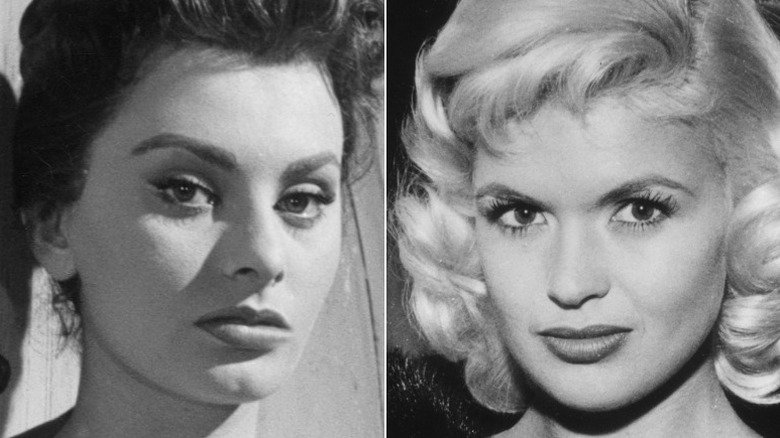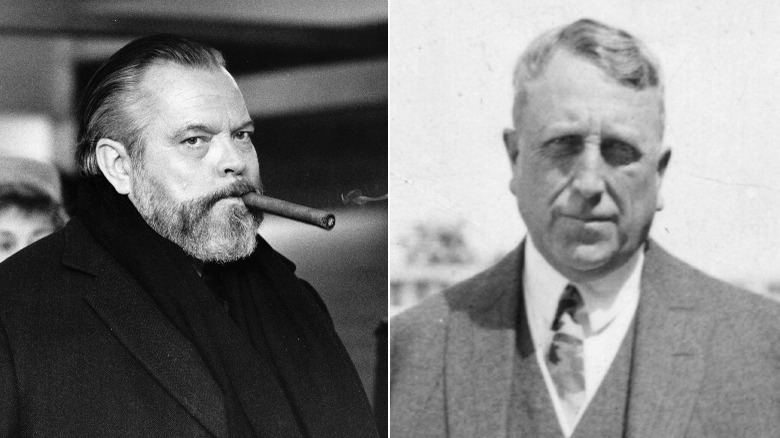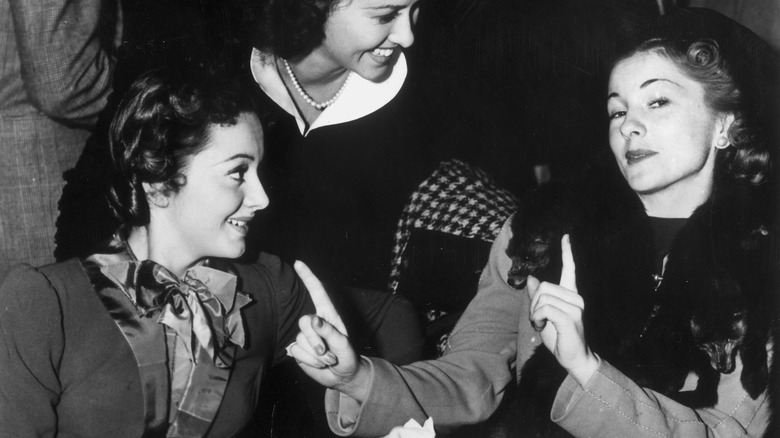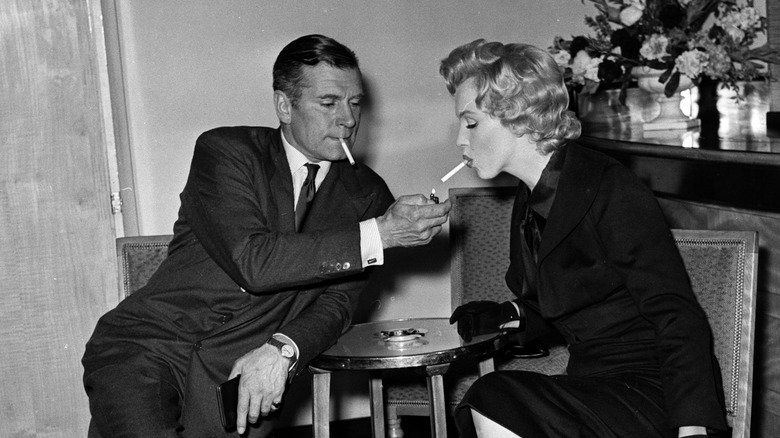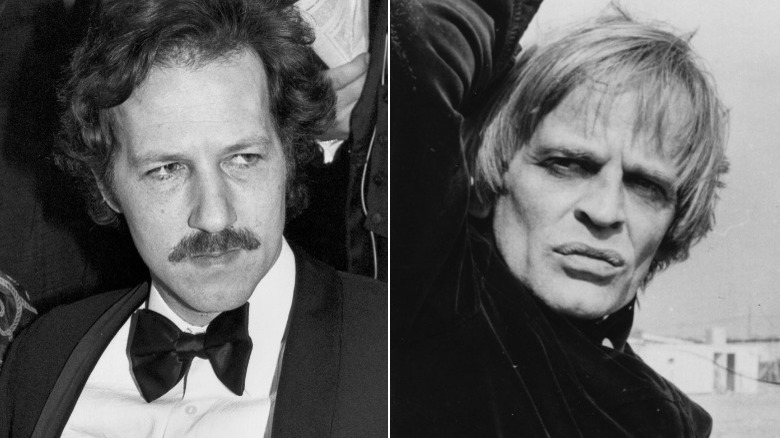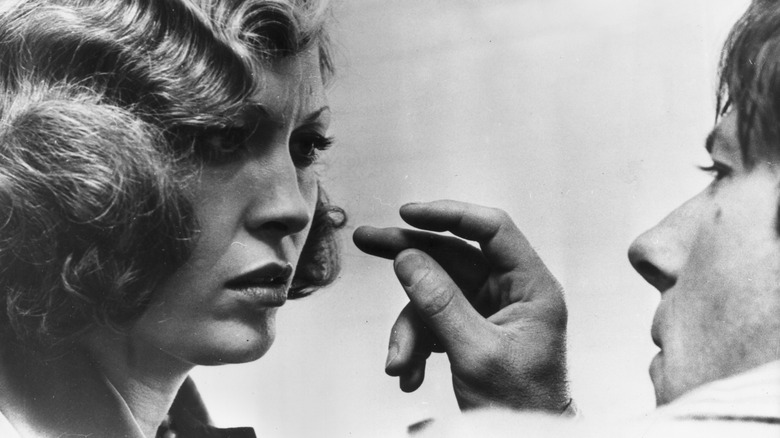Old Hollywood Feuds That Got Out Of Hand
The Golden Age of Hollywood came to be in the early 1920s, with the industry being controlled by five major studios: Paramount, MGM, Fox, Warner Brothers, and RKO, per History. These studios were essentially given carte blanche over their talent, often controlling every aspect of their stars' lives, from the way they looked, the abhorrent hours they worked, to even approving who they were allowed to date (via Reel Rundown).
According to FSR, it seemed like everyone wanted to become a star in Old Hollywood, and thousands of people flocked to Los Angeles with one end goal in sight: to see their names lit up on a marquee. Of course, with such stiff competition (and the pressures associated with succeeding once an actor actually landed a contract), The Golden Age of Hollywood became a breeding ground for conflict and rivalry.
Image was everything in Old Hollywood, and as representatives of their studios, actors were obligated to behave a certain way both on camera and off. Of course, things didn't always go according to plan, and Tinseltown employers sometimes found great difficulty keeping their talent in check. Let's take a look at some of the most legendary Old Hollywood feuds that got out of hand.
Bette Davis vs. Joan Crawford
Both Bette Davis and Joan Crawford were Hollywood heavyweights during its Golden Age. According to Biography, while Crawford's acting talents weren't necessarily beloved by everyone, Davis saw much more critical success, starring in almost a whopping 100 films in her lifetime. The feud between the two leading ladies has become Tinseltown lore, as they tirelessly threw jabs at one another in what was ultimately a race of egos.
Davis and Crawford's rivalry kicked off in 1933. Crawford was already considered an A-list star, while Davis was still making a name for herself, having finally scored a leading role in "Ex-Lady." According to "Joan Crawford: Hollywood Martyr," Davis was thrilled at the possibility of newspapers promoting the flick as front-page news, but Crawford's announcement that she was divorcing her first husband suddenly took center stage. Ultimately, publications gave scant reviews of "Ex-Lady," while Crawford's personal drama snagged four pages. The moment sparked a feud between the two women — and it's one that lasted an incredible four decades, with jabs both professional and personal being hurled both ways (via Harper's Bazaar).
The pair did end up starring in a movie together, in 1962, for "What Ever Happened To Baby Jane?" Per "Not the Girl Next Door," it was Crawford who reached out to Davis, knowing that they would be perfect for the film. Their time on set was anything but professional, with Davis even accusing Crawford of intentionally injuring her while they filmed a scene (via Harper's Bazaar).
Debbie Reynolds vs. Elizabeth Taylor
Elizabeth Taylor and Debbie Reynolds' legendary spat was due to a love triangle, which resulted in the two not speaking for years. According to People, Reynolds and Taylor met when they were teens and both signed to MGM. Per Biography, the pair remained friends as they grew into adulthood, with Reynolds marrying Eddie Fisher in 1955 and Taylor tying the knot with Mike Todd two years later — with Reynolds serving as the matron of honor.
Sadly, Taylor's marital bliss was cut short in 1958 after Todd tragically died in a plane crash. Curiously enough, it was Fisher who immediately ran to the "Cleopatra" star's side to console her, and a mere month later, he separated from Reynolds (via Biography). While the press had a field day with the news, Taylor and Reynolds' friendship came to a halt. Decades later, in 2010, the "Singin' in the Rain" actor revealed in an interview with Daily Mail that she believed Taylor's affair with Fisher actually began in 1957 when her husband was away touring. A lonely Reynolds phoned her friend and was horrified to hear Fisher on the other line.
Fisher ended up marrying Taylor (although they divorced in 1964), and, of course, the two women didn't speak for years. According to Closer Weekly, seven years after Taylor betrayed her friend, the two finally reconciled after discovering they were stuck together on a ship heading from New York to England. It was initially Reynolds who extended the olive branch.
Dean Martin vs. Jerry Lewis
Jerry Lewis was a huge part of Dean Martin's climb to the top of the A-list. Per Biography, in the mid-1940s, Martin was still merely a nightclub singer, yet after meeting Lewis at a club performance one evening in 1946, the pair hit it off, and by the following year, their comedy act was born. So popular were Lewis and Martin together that between the years of 1949 and 1956, the duo made an incredible 16 films together.
However, behind closed doors, the situation was less than stellar. As the WSJ detailed, Martin was done with being perceived as the straight man to Lewis' wacky antics, while Lewis detested that his partner in crime didn't have the same workaholic mentality as he did. A significant point of contention came in 1954, while the pair were promoting their film, "Living It Up." According to USA Today, Look magazine cropped Martin out of a photo for the movie, and things never recovered after that. By 1956, Lewis and Martin went their separate ways.
Per People, the two refused to speak to one another for a whopping 20 years until their mutual friend Frank Sinatra attempted a live, on-stage reunion in 1976. Although they were civil for the cameras, it took another 10 years for the pair to reconcile, after Martin's son's untimely passing in a plane crash in 1987. After Martin died in 1995, Lewis took the blame for their bitter split many decades ago.
Marilyn Monroe vs. Jayne Mansfield
When Jayne Mansfield finally reached the A-list in the late 1950s, Marilyn Monroe was already a bonafide Hollywood icon. The pair were already on bad terms before they even met: according to the Vintage News, Mansfield was considered by many a cheaper version of Monroe, which certainly irked the original blonde sex symbol (via Biography).
So annoyed was Monroe with her rival that she once snapped back at Lawrence J. Quirk, author of "The Kennedys in Hollywood," declaring, "All she does is imitate me ... I wish I had some legal means to sue her" (via The Washington Post). After a confused Quirk asked her why she would want to take legal action against Mansfield, the "Gentlemen Prefer Blondes" star quipped, "For degrading the image."
But it wasn't just Mansfield being an imitation of her that annoyed Monroe. As Quirk notes, Mansfield purportedly took note of her rival's alleged affair with John F. Kennedy in the mid-1950s and decided she wanted a slice of presidential pie, too. Utilizing the help of JFK's brother-in-law, Peter Lawford, the "Promises! Promises!" actor had her own secret tryst with Kennedy, later telling Lawford, "Everyone in Hollywood and Washington knows about it anyway ... I'll bet Marilyn's pissed," at the concept of Monroe finding out (via The Washington Post).
Marlon Brando vs. Frank Sinatra
Frank Sinatra and Marlon Brando were both A-list icons in the mid-1950s, yet they came from incredibly different worlds. As Ben Mankiewicz, host of TCM, explained to Closer Weekly, Sinatra was a quintessential, glamorous Old Hollywood crooner of the '40s. Brando, on the other hand, "had open disdain for Hollywood."
The pair's feud began in 1954 when Brando snagged the lead part in "On the Waterfront" — a role that Sinatra was gunning for himself. Although there wasn't any bad blood from Brando's side at this point, "Frank detest[ed] the ground that Brando walked on," revealed biographer James Kaplan to Closer Weekly. When the pair became co-stars the following year for the musical-comedy "Guys and Dolls," things only worsened, and Brando started antagonizing Ol' Blue Eyes. According to Mankiewicz, during a scene where Sinatra was eating cheesecake, Brando would purposely mess up his lines. The result? Sinatra would have to keep eating for multiple takes on end.
The last straw, however? According to Closer Weekly, there was one day on set where Sinatra's estranged wife, Ava Gardner, decided to visit Brando in his dressing room, sending Sinatra in an alleged jealous rage. As Brando's friend, Carlo Fiore, explained in "Brando Unzipped," shortly after the Gardner incident, the actor was kidnapped by three men who forced him into a car and threatened to kill him at gunpoint for two hours. After Brando was released and spoke to Fiore, he was convinced that it was Sinatra (who had alleged mafia ties) who sent his men after him.
Bud Abbott vs. Lou Costello
Comedy duo Bud Abbott and Lou Costello are considered legends in the world of rapid-fire, slapstick comedy, having performed together in films, television, on stage, and on radio (via Britannica). Formed in 1936, they've influenced countless comedians to this day, such as Jerry Seinfeld, who even dropped subtle references to the icons on his now-legendary series, "Seinfeld" (via the New York Times)
The winning formula for the duo was the roles they played. Abbott, who acted as more of a straight man, was the serious schemer, while Costello played the more childlike, comedic role. And while this made for phenomenal on-screen chemistry, the two men grew to hate one another off-camera. While the actors had their own personal problems they were dealing with (Abbott struggled with alcoholism while Costello had severe issues with rheumatic fever), in 1945, their relationship soured after Abbott hired a former maid of Costello's, per The Telegraph. This resulted in Costello telling the tabloids that Abbott was a drunk, while Abbott himself publicly declared he'd get physical with his on-screen chum. Sadly, Abbott and Costello were forced to keep working together under contract, but they didn't speak when cameras stopped rolling.
According to The Telegraph, their most serious row happened in 1957, after Errol Flynn played a practical joke on the pair and their families: inviting them for a screening and "accidentally" playing an adult film in front of them. While Flynn acted innocent, Abbott and Costello blamed one another, thus leading to their final break-up.
Sophia Loren vs. Jayne Mansfield
Jayne Mansfield's climb to Tinseltown's A-list was an interesting one, mainly because her critics didn't exactly think she was that good of an actor. Considered by The Hollywood Reporter as the first star who was "famous for being famous," Mansfield knew how to use the tabloids to her advantage. "Jayne Mansfield: The Girl Couldn't Help It" once quoted the blonde icon as saying, "The real stars are not good actors or actresses. They're personalities."
One of Mansfield's most well-known publicity stunts involved the celebrated actor, Sophia Loren, which allegedly irked the Italian star so much, it was responsible for Loren's overall problems with Hollywood. As explained by Vanity Fair, in 1957, Loren visited Hollywood, attending a press event in her honor at Romanoff's restaurant in Beverly Hills. After Loren was seated at the table, Mansfield came and crashed the soirée in an incredibly low-cut dress. As she leaned over Loren's table with a beaming smile plastered on her face, Mansfield suffered a wardrobe malfunction — one that photographers have since immortalized, complete with Loren's burning side-eye. "She knew everyone was watching," the "Houseboat" star told Entertainment Weekly decades later. "I'm staring at her nipples because I am afraid they are about to come onto my plate."
Interestingly enough, after Mansfield's tragic death in 1967, whenever a fan came up to Loren with the iconic photo asking for an autograph, Loren would always decline "out of respect" for Mansfield (via Entertainment Weekly).
Orson Welles vs. William Randolph Hearst
When Orson Welles released his magnum opus "Citizen Kane" in 1941, he was already a Hollywood heavyweight, having terrified audiences three years prior with his infamous radio adaptation of H.G. Wells' "The War of the Worlds," which caused alleged widespread hysteria that aliens were invading America (via Smithsonian Magazine). "Citizen Kane," which has since been lauded as one of the greatest films of all time, completely flopped at the time of its release, per History — all thanks to newspaper mogul William Randolph Hearst.
According to the National Post, the role of Charles Foster Kane was said to have been "partially inspired" by Hearst himself, who was so offended by the on-screen portrayal that he prohibited newspapers from mentioning the movie and banned movie theaters from showing it. "[He] tried to have it destroyed," recalled Welles while on "The Dick Cavett Show" in 1970, adding that he actually met Hearst for the first time during the opening night of the film, running into him in an elevator in San Francisco. Welles introduced himself to the publisher and invited him to the premiere, while Hearst merely ignored him. "I said, 'Well, Mr. Kane would have come,'" Welles quipped.
Hearst died in 1951, and in the years to follow, it appears his younger family members don't harbor any sort of similar hatred. As his great-grandson and president of the Hearst Corporation, Steve Hearst, said in a statement in 2012 (via National Post), he sees "Citizen Kane" as a "remarkable" movie, noting that it should celebrate both the publisher and the director.
Joan Fontaine vs. Olivia de Havilland
The feud between Joan Fontaine and Olivia de Havilland goes past a Hollywood squabble: it was a familial rivalry. According to Biography, the two sisters were born a mere 15 months apart, with their competitiveness having begun while they were still children. The younger sister, Joan, believed their mother preferred Olivia, so the pair often fought, ranging from small slaps to the time Olivia broke her sister's collarbone trying to pull her into a pool. Disturbingly enough, an interview with Life magazine in 1942 revealed that when she was 9, Joan plotted to kill her sister if she kept hitting her — a plan that clearly didn't come to fruition.
As they grew older, Joan lived with her father in Japan for a few years, while Olivia was the first to embark on her Hollywood career. Per Vanity Fair, by 1938, the elder sister was finally a Tinseltown icon, and Joan worked "tirelessly" to catch up upon her return to America, while also acting as Olivia's chauffeur, as her sibling still didn't know how to drive (via The Hollywood Reporter) — no doubt a blow to Joan's ego.
As Joan eventually joined her sister in the ranks of acting royalty by the 1940s, it appears that fame never repaired their lifelong feud. Speaking to People in 1978, Fontaine declared, "You can divorce your sister as well as your husbands. I don't see her at all and I don't intend to."
Laurence Olivier vs. Marilyn Monroe
Working together on 1957's "The Prince and the Showgirl" was anything but easy for co-stars Laurence Olivier and Marilyn Monroe. According to The Telegraph, the two actors were in completely different parts of their careers by the time they collaborated, with Olivier already a heavyweight in the industry both in front of the camera and behind it. On the other hand, Monroe played stereotypical dumb blonde roles in the early 1950s (via Biography), which led Olivier to consider her his "inferior."
However, acting talents weren't the only reason Monroe and Olivier's relationship immediately turned sour. Kenneth Branagh, who played Olivier in 2011's "My Week with Marilyn," revealed to NPR that Monroe would constantly show up late to set (or not at all) and had trouble memorizing her lines. "That created, often, comic frustration for Olivier," noted Branagh. Of course, Olivier's treatment of the blonde bombshell irked Monroe — along with the fact that he simply couldn't see her as the sex symbol that others so openly acknowledged. "She never forgave him for saying to her once, 'Try and be sexy,'" explained the flick's cinematographer, Jack Cardiff, to The Telegraph.
Sadly, when Monroe died of a drug overdose in 1962, even the circumstances of her death did nothing to soften the hatred Olivier carried for his former co-star. According to Cardiff, when he ran into the actor in 1984 and asked him about his time with Marilyn on set, Olivier merely replied, "She was a bi**h" (via The Telegraph).
Werner Herzog vs. Klaus Kinski
German director Werner Herzog and actor Klaus Kinski produced some incredible films together, having collaborated five times throughout their careers, per IndieWire. As it turns out, the pair knew each other since they were teens, with Herzog having met Kinski when he moved into the same Munich apartment building he lived in (via The Guardian). When they began working together, their professional relationship was messy and volatile, and although their movies were legendary, so were their spats off-camera.
The most turbulent flick the pair worked together on was 1972's "Aguirre, the Wrath of God," which took place in Peru. According to IndieWire, by this time in Kinski's career, he was already well-known for being an incredibly difficult actor to work with, even threatening to walk off the set after a disagreement with Herzog. As the director later recalled Kinski packing up his things and getting ready to leave, he bluntly told him, "If you leave the set now, you will reach the bend — the next bend of the river and I will shoot you — will have eight bullets through your head" (via Far Out). Naturally, this was enough to get Kinski to stay.
Kinski's dramatic antics during the filming of "Aguirre" didn't just irk Herzog, however. As revealed by The Guardian, at one point, the Native Peruvians playing extras in the film actually offered to kill Kinski for Herzog, which he, of course, declined.
Faye Dunaway vs. Roman Polanski
The fight between Faye Dunaway and Roman Polanski on the set of Academy Award-winning flick "Chinatown" will go down in history as one of the most notorious Old Hollywood feuds — and with good reason, too. "The friction between Roman and I began from the start," Dunaway reflected in the years after completing the 1974 flick, per The Telegraph. As the "Bonnie and Clyde" star further explained, Polanski had already left a bad impression during the initial makeup test, after he wasn't happy with the actor's look. According to Dunaway, Polanski grabbed the makeup brush himself and aggressively applied it to her with disastrous results.
On Polanski's end, he claimed Dunaway displayed a "certifiable proof of insanity" — a claim he deduced after plucking a strand of hair from the star during a scene where he believed it was ruining his take (via Far Out). Dunaway, who insisted the director harmed her, marched off the set after the incident.
But neither of these quarrels will ever be as legendarily horrific as the following story. According to The Guardian, during the filming of one scene, Polanski instructed Dunaway to wait in a car. After asking the director if she could go to the washroom, Polanski demanded she stay in the vehicle. When he later returned to talk to Dunaway, she threw a cup of liquid out of the car window and at his face, leading the director to yell, "You c**t, that's piss!"
